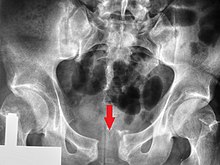| Pubic symphysis diastasis | |
|---|---|
 | |
| Post traumatic pubic symphysis diastasis | |
| Specialty | Orthopaedic |
Pubic symphysis diastasis (also known as diastasis symphysis pubis) is the separation of normally joined pubic bones, as in the dislocation of the bones, without a fracture that measures radiologically more than 10 mm. Separation of the symphysis pubis is a rare pathology associated with childbirth and has an incidence of 1 in 300 to 1 in 30,000 births. It is usually noticed after delivery but can be observed up to six months postpartum.[1] Risk factors associated with this injury include cephalopelvic disproportion, rapid second stage of labor, epidural anesthesia, severe abduction of the thighs during delivery, or previous trauma to the pelvis. Common signs and symptoms include symphyseal pain aggravated by weight-bearing and walking, a waddling gait, pubic tenderness, and a palpable interpubic gap. Treatment for pubic symphysis diastasis is largely conservative, with treatment modalities including pelvic bracing, bed rest, analgesia, physical therapy, and in some severe cases, surgery.[2]
- ^ Herren, C.; Sobottke, R.; Dadgar, A.; Ringe, M.J.; Graf, M.; Keller, K.; Eysel, P.; Mallmann, P.; Siewe, J. (June 2015). "Peripartum pubic symphysis separation – Current strategies in diagnosis and therapy and presentation of two cases". Injury. 46 (6): 1074–1080. doi:10.1016/j.injury.2015.02.030. PMID 25816704.
- ^ Urraca-Gesto, M. Alicia; Plaza-Manzano, Gustavo; Ferragut-Garcías, Alejandro; Pecos-Martín, Daniel; Gallego-Izquierdo, Tomás; Romero-Franco, Natalia (2015). "Diastasis of symphysis pubis and labor: Systematic review" (PDF). Journal of Rehabilitation Research and Development. 52 (6): 629–640. doi:10.1682/JRRD.2014.12.0302. ISSN 0748-7711. PMID 26560443.
